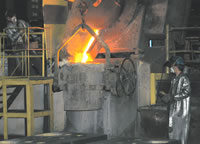 For a company celebrating its 100th year in business, Wabi Iron & Steel Corp. shows no signs of slowing down.
For a company celebrating its 100th year in business, Wabi Iron & Steel Corp. shows no signs of slowing down.
The New Liskeard foundry and fabricating business is in the midst of a $2.5 million plant and equipment upgrade.
At the same time, it is introducing new holding and emergency-braking solutions for mine conveyances and researching the use of plastic and resin-based composites for the construction of skips and cages.
Loans of $1 million from the Northern Ontario Heritage Corporation and $1.5 million from the Northern Ontario Grow Bonds Corporation are being used to acquire a thermal-fired sand reclamation system, an automated material handling system for molds and new equipment for its machine shop.
Exports currently account for approximately half of the company’s business, says Wabi Iron & Steel president Peter Birnie. “The U.S. market has been very good for us and we’ve had some real success in Australia.”
The company fabricates skips, cages, loading stations, truck loading chutes and ore cars.
It recently completed the sale of a multi-million dollar truck loading system incorporating lasers, cameras and wireless controls for a mining operation in Australia. The 80-tonne trucks used in the ore loading operation are equipped with monitors and joysticks, allowing drivers to correctly position their vehicles, open and close the chutes and view video of the ore as it is loaded.
“The driver loads the truck by viewing the cameras on his monitor, but if he makes an error in judgment, a backup laser system overrides the manual controls and closes the chute,” explained Stan Gorochinski, manager of mining services. “It takes just over one minute to fill an 80-tonne truck.”
Wabi Iron & Steel recently introduced a new cage holding solution and ended its relationship with South Africa’s Horne Hydraulics, which markets the Levelok holding system.
Called Loc-N-Load, the Wabi Iron & Steel system “is completely different,” said Gorochinski. “We’re using wireless control technology and closed loop hydraulics, which are huge improvements.”
The system is designed to hold a cage in place during loading and unloading of heavy loads, reducing slippage caused by rope stretch.
The Loc-N-Load system is designed for cages only, unlike the Horne Hydraulics product that is also used for skips.
“We went completely opposite in design philosophy there,” said Gorchinski. “Our philosophy is that it’s better to chair a skip than to hold it.
“Chairing isn’t a new technology, but we’ve cleaned up all the problems associated with seating a skip.”
Most mines in North America still use chairing systems to hold conveyances, but they only work in one direction, said Gorochinski.
“If you put a heavy load into a mine cage on surface and you send it underground, there’s a lot of stored energy in the hoist cable and as you take that load off, the energy acts as a huge spring and thrusts the cage upwards. When you hold the conveyance, you don’t have this problem.”
Braking system
Wabi Iron and Steel has also developed a new emergency braking system as an alternative to so-called safety dogs, knife-like mechanisms that engage and arrest the fall of a conveyance by eating into wooden guides, or timbers, in the event of a catastrophic rope failure.
The Wabi E.brake works with the Loc-N-Load system, clamping the guides and gradually decelerating the descent of the conveyance “like a big disk brake on a car.”
“We have one system on an old Leveloc holding system in Kansas and we’re working with the Ministry of Labour to get approval to use it in Ontario,” said Gorochinski.
One of the major benefits of the E.brake system is that it reduces the weight of a conveyance by approximately one tonne. Conveyance weight is becoming more of an issue as mining companies follow orebodies to depth and strive to maximize their hoisting capacity.
The thermal-fired sand reclamation system the company is acquiring will divert between 3,000 and 4,000 tonnes of sand from the municipality’s landfill site every year, while also improving casting quality.
The new material handling system for molds will create a much more efficient operation, reducing manual handling and the use of overhead cranes.
“It’s almost a production line setup where the molds are moved along conveyors and everything is sequenced as the operation unfolds,” said Gorochinski.
A new drill press – one of the largest in Northern Ontario – will drill holes of up to three inches in diameter and accommodate hardnesses of up to 500 to 600 Birnell.
Celebrations to mark Wabi Iron & Steel’s centennial include a commemorative book about the company’s colourful history and a fundraising initiative in support of mental health. Limited edition prints of a foundry worker hand pouring molten metal at Wabi Iron & Steel are being sold for $500 to raise money for We All Belong, a not-for-profit organization founded by Birnie to change the way people think about mental illness.

